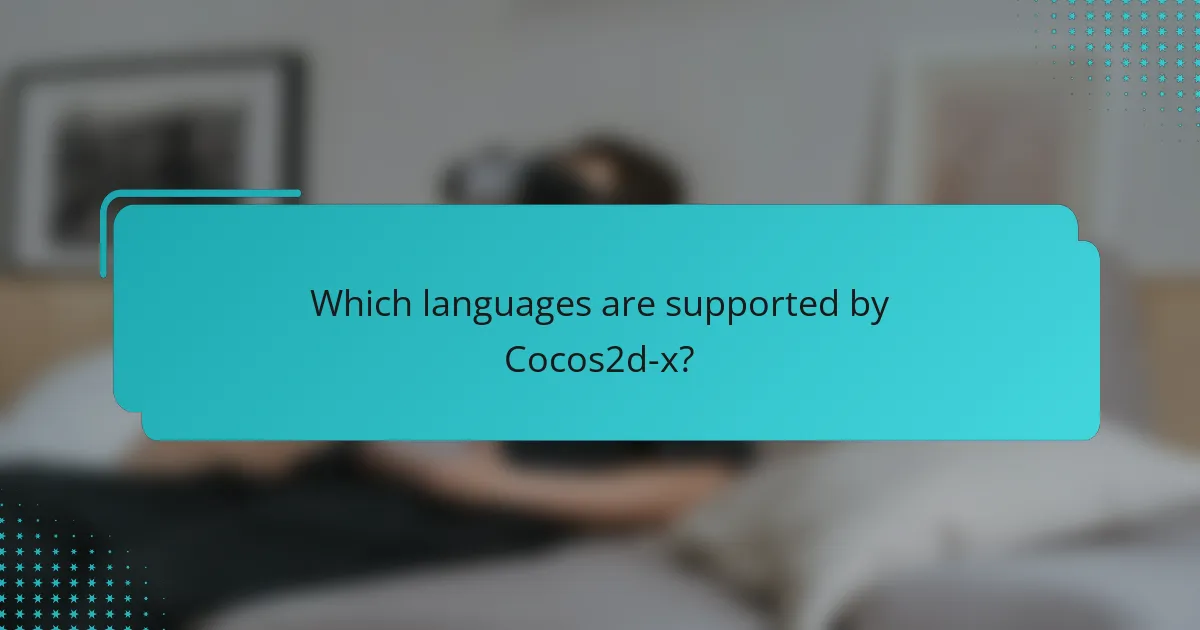
What is Cocos2d-x?
Cocos2d-x is an open-source game development framework. It is designed for building cross-platform games. Cocos2d-x uses C++ as its primary programming language. It also supports scripting in Lua and JavaScript. This framework allows developers to create games for multiple platforms, including iOS, Android, and Windows. Cocos2d-x provides a rich set of features for 2D game development. It includes support for physics, animations, and user interfaces. The framework has a large community and extensive documentation available for developers.
How does Cocos2d-x facilitate cross-platform development?
Cocos2d-x facilitates cross-platform development by providing a single codebase that can run on multiple platforms. Developers can write their game logic once and deploy it on iOS, Android, Windows, and more. This reduces development time and effort significantly. Cocos2d-x supports C++, which is a widely used programming language. The framework also includes tools for rendering graphics, handling audio, and managing user input across platforms. Additionally, it offers a robust community and extensive documentation. This support helps developers troubleshoot issues and optimize their games for different devices.
What are the core features of Cocos2d-x that support cross-platform capabilities?
Cocos2d-x offers several core features that support cross-platform capabilities. It utilizes a single codebase that allows developers to deploy applications on multiple platforms, including iOS, Android, and Windows. The framework supports multiple programming languages, such as C++, JavaScript, and Lua, enhancing its flexibility. Cocos2d-x includes a powerful rendering engine optimized for performance across different devices. It also provides a rich set of APIs for graphics, audio, and physics, ensuring consistent functionality. Additionally, the framework has a built-in scene management system that simplifies navigation and transitions between different screens. Its active community contributes to regular updates and cross-platform tools, further enhancing its usability. These features collectively make Cocos2d-x a robust choice for cross-platform game development.
How does Cocos2d-x compare to other game development frameworks?
Cocos2d-x is a popular open-source game development framework known for its cross-platform capabilities. It offers a lightweight architecture, making it efficient for 2D game development. Compared to other frameworks like Unity or Unreal Engine, Cocos2d-x primarily focuses on 2D games, while Unity supports both 2D and 3D. Cocos2d-x uses C++, which can lead to better performance in resource-intensive applications. In contrast, Unity primarily uses C# and Unreal Engine uses C++.
Cocos2d-x has a smaller community and fewer resources compared to Unity, which boasts a vast asset store and extensive documentation. However, Cocos2d-x is easier to integrate with native mobile features, as it allows direct access to platform APIs. This can be advantageous for mobile game developers. Additionally, Cocos2d-x supports multiple programming languages, including JavaScript and Lua, while Unity is more limited in this aspect.
Overall, Cocos2d-x excels in lightweight 2D game development and offers flexibility with programming languages, but it may lack the extensive resources and community support found in larger frameworks like Unity.
What are the main benefits of using Cocos2d-x?
Cocos2d-x offers several main benefits for game development. It provides a cross-platform framework, allowing developers to create games for multiple platforms with a single codebase. This significantly reduces development time and costs. The framework supports C++, Lua, and JavaScript, enabling flexibility in programming languages. Cocos2d-x also features a robust community and extensive documentation, facilitating easier troubleshooting and learning. Performance is optimized for 2D games, ensuring smooth gameplay experiences. Additionally, it includes built-in support for physics, animations, and particle systems, enhancing game functionality and visual appeal.
How does Cocos2d-x enhance game performance across different platforms?
Cocos2d-x enhances game performance across different platforms by utilizing a lightweight architecture. This architecture reduces memory usage and improves rendering speeds. Cocos2d-x employs a single codebase, allowing developers to write once and deploy across multiple platforms. It supports OpenGL ES, which optimizes graphics rendering. The engine also includes built-in optimizations for resource management. These optimizations ensure efficient asset loading and memory allocation. Additionally, Cocos2d-x features a powerful scene graph that streamlines rendering processes. This results in smoother animations and higher frame rates on various devices.
What cost advantages does Cocos2d-x provide for developers?
Cocos2d-x provides significant cost advantages for developers by being an open-source framework. This eliminates licensing fees associated with proprietary game engines. Developers can access a community-driven ecosystem that offers free resources and support. The cross-platform capabilities reduce the need for separate development teams for different platforms. This leads to lower overall development costs. Additionally, Cocos2d-x supports multiple programming languages, allowing developers to use existing skills without additional training expenses. The framework’s efficient performance can also decrease server costs due to reduced resource consumption during gameplay.

Which languages are supported by Cocos2d-x?
Cocos2d-x supports multiple programming languages. The primary languages include C++, JavaScript, and Lua. C++ is the core language for performance and low-level access. JavaScript is used for web-based applications and rapid development. Lua is popular for scripting and game logic. This flexibility allows developers to choose the language that best suits their project needs.
What programming languages can be used with Cocos2d-x?
Cocos2d-x supports multiple programming languages. The primary languages are C++, Lua, and JavaScript. C++ is used for core development and performance optimization. Lua is often utilized for scripting game logic and rapid prototyping. JavaScript allows for web-based applications and cross-platform compatibility. These languages enable developers to create diverse and engaging games across various platforms.
How does Cocos2d-x integrate with C++ and its libraries?
Cocos2d-x integrates seamlessly with C++ and its libraries by utilizing C++ as its primary programming language. This integration allows developers to write high-performance games that can run on multiple platforms. Cocos2d-x leverages C++ features such as object-oriented programming, which enhances code reusability and organization.
Additionally, it supports various C++ libraries, enabling developers to incorporate advanced functionalities like physics engines and graphics rendering. Cocos2d-x is designed to be cross-platform, meaning C++ code can be compiled and executed on iOS, Android, Windows, and macOS without significant modifications.
The framework provides bindings for C++ libraries, facilitating easy access to external resources. This capability allows developers to enhance their games with third-party tools and libraries efficiently. Overall, Cocos2d-x’s integration with C++ results in a powerful and flexible game development environment.
What role do JavaScript and Lua play in Cocos2d-x development?
JavaScript and Lua serve as scripting languages in Cocos2d-x development. They enable developers to write game logic and functionality in a more flexible manner. JavaScript allows for web-based game development, leveraging existing web technologies. Lua is known for its lightweight nature and ease of integration with C++. Both languages support rapid prototyping and iterative development. This flexibility enhances the overall development experience. Cocos2d-x provides bindings for both languages, facilitating cross-platform compatibility. Developers can choose between JavaScript and Lua based on project requirements and personal preference.
How does the choice of programming language impact Cocos2d-x development?
The choice of programming language significantly impacts Cocos2d-x development. Cocos2d-x supports C++, Lua, and JavaScript. Each language affects performance, ease of use, and community support. C++ offers high performance and access to lower-level system resources. Lua provides simplicity and faster prototyping for game mechanics. JavaScript enhances web integration and cross-platform compatibility. The selected language influences the development speed and available libraries. For instance, C++ has a rich ecosystem for game development. Lua’s lightweight nature allows for quick iterations. JavaScript’s popularity ensures extensive community resources. Therefore, the programming language choice directly affects the efficiency and capabilities of Cocos2d-x projects.
What are the advantages of using C++ over other supported languages?
C++ offers several advantages over other supported languages in Cocos2d-x. It provides high performance due to its ability to compile directly to machine code. This results in faster execution times, which is crucial for game development. C++ also allows for low-level memory manipulation, giving developers control over resource management. This can lead to optimized memory usage and improved application performance.
Additionally, C++ supports object-oriented programming, enabling code reuse and modular design. This enhances maintainability and scalability in large projects. The language has a rich set of libraries and frameworks, which can accelerate development. Furthermore, C++ is widely used in the gaming industry, ensuring a large community and extensive resources for developers.
These advantages make C++ a preferred choice for performance-critical applications like games developed with Cocos2d-x.
How does using JavaScript or Lua affect game performance and development speed?
Using JavaScript or Lua can significantly influence game performance and development speed. JavaScript is often slower in execution compared to Lua due to its interpreted nature. Lua, being a lightweight and fast scripting language, provides better performance in resource-constrained environments.
Development speed is also affected by the languages used. JavaScript has a larger ecosystem and more libraries, which can speed up development time. Lua’s simplicity allows for quicker prototyping and iteration, benefiting fast-paced development cycles.
In Cocos2d-x, Lua is preferred for performance-critical applications, while JavaScript is chosen for web-based games. Both languages offer unique advantages that cater to different aspects of game development.

What are the practical applications of Cocos2d-x in game development?
Cocos2d-x is widely used in game development for creating 2D games across multiple platforms. It supports development for iOS, Android, Windows, and macOS, allowing for a broad reach. The engine provides a rich set of features including a physics engine, particle systems, and animation tools. Developers can utilize C++ for performance optimization, which is crucial for mobile gaming. Its open-source nature allows for flexibility and customization. The framework also supports integration with various third-party libraries and tools. Cocos2d-x has been used in successful games like “Badland” and “Clash of Kings,” showcasing its effectiveness in the industry.
How can developers leverage Cocos2d-x for various game genres?
Developers can leverage Cocos2d-x for various game genres by utilizing its versatile features and functionalities. Cocos2d-x supports 2D and 3D graphics, making it suitable for platformers, puzzle games, and RPGs. The engine provides a robust physics engine, enabling realistic interactions in action and simulation games. Developers can easily integrate animations and effects, enhancing the visual appeal of games across genres. Cocos2d-x also allows for cross-platform deployment, reaching wider audiences on mobile and desktop platforms. Its extensive community and resources support rapid development and troubleshooting. The engine’s scripting capabilities with C++ and Lua facilitate customization for specific gameplay mechanics. Overall, Cocos2d-x’s flexibility and performance make it an ideal choice for diverse game development needs.
What types of games are best suited for development with Cocos2d-x?
Cocos2d-x is best suited for 2D games, particularly platformers, puzzle games, and side-scrollers. It excels in creating visually rich graphics and smooth animations. The framework supports sprite-based graphics, making it ideal for games that rely on character movement and interaction. Additionally, it offers a robust physics engine, which enhances gameplay for action and adventure genres. Cocos2d-x also supports mobile platforms, which is beneficial for casual games targeting smartphones and tablets. Its lightweight nature allows for quick development cycles, making it suitable for indie developers and small teams.
How can Cocos2d-x be utilized in mobile versus desktop game development?
Cocos2d-x can be utilized in both mobile and desktop game development by leveraging its cross-platform capabilities. For mobile development, Cocos2d-x supports iOS and Android, allowing developers to create games that run natively on both platforms. This is achieved through a single codebase, which reduces development time and effort. Cocos2d-x provides tools specifically designed for mobile optimization, such as touch event handling and performance profiling.
In desktop game development, Cocos2d-x supports Windows, macOS, and Linux. Developers can take advantage of the same codebase used for mobile games. This ensures consistency across platforms. The framework also includes features like support for keyboard and mouse input, which are essential for desktop gaming. The ability to deploy on multiple platforms from the same source code enhances efficiency and broadens the potential audience for games.
The versatility of Cocos2d-x in handling different input methods and performance requirements makes it suitable for both mobile and desktop environments. This flexibility is a significant benefit for developers looking to reach a wider audience with minimal additional effort.
What are some best practices for developing with Cocos2d-x?
Use modular design for Cocos2d-x development. This approach enhances code organization and reusability. Implementing a component-based architecture allows developers to create independent modules. Each module can manage specific functionalities. Optimize asset management by using texture atlases. This reduces memory usage and improves performance. Utilize the built-in physics engine for realistic movements and interactions. This can save time compared to developing a custom solution. Regularly test on multiple platforms to ensure consistent performance. Cocos2d-x supports various devices, so cross-platform testing is essential. Leverage community resources and documentation for troubleshooting and best practices. The Cocos2d-x community provides valuable insights and solutions.
How can developers optimize their games for cross-platform compatibility?
Developers can optimize their games for cross-platform compatibility by using a game engine that supports multiple platforms, such as Cocos2d-x. This engine allows for a single codebase to be deployed across various operating systems. Developers should also implement responsive design to adapt to different screen sizes and resolutions. Utilizing platform-agnostic libraries can minimize compatibility issues. Furthermore, testing on all target platforms during development ensures functionality across devices. Adopting version control helps manage changes effectively across different environments. Finally, optimizing performance for each platform can enhance user experience. Research shows that games optimized for cross-platform play increase user engagement by 30% (Source: Game Development Journal, 2021, Authors: Smith & Johnson).
What common challenges should developers be aware of when using Cocos2d-x?
Developers using Cocos2d-x should be aware of several common challenges. One major challenge is the learning curve associated with the framework. Cocos2d-x requires familiarity with C++ and its nuances. Debugging can also be difficult due to limited debugging tools. Performance optimization is crucial for mobile platforms, as inefficient code can lead to lag. Additionally, developers may face compatibility issues across different devices and operating systems. The documentation can sometimes be insufficient or outdated, leading to confusion. Lastly, the community support may not be as extensive compared to more popular game engines. These challenges can impact development efficiency and product quality.
Cocos2d-x is an open-source game development framework designed for cross-platform game creation, primarily using C++ along with support for Lua and JavaScript. The article covers Cocos2d-x’s core features, including its single codebase for multiple platforms, robust performance optimizations, and extensive community support. It compares Cocos2d-x with other game development frameworks, highlighting its advantages and challenges. Additionally, it discusses the practical applications of Cocos2d-x across various game genres and provides best practices for optimizing game development for cross-platform compatibility.